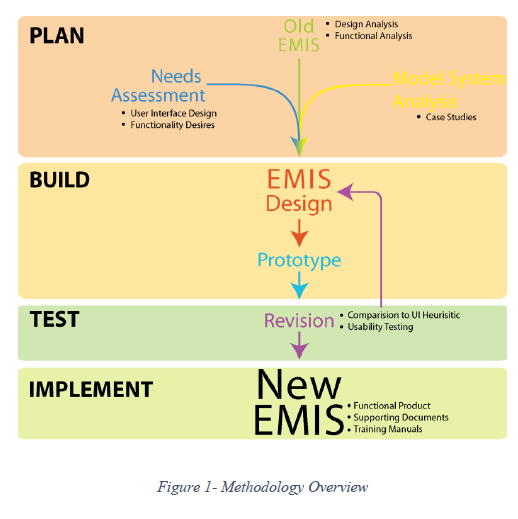Emergency Management Information System Design for the London Borough of Hounslow
Abstract
Our report, prepared for the London Borough of Hounslow, outlines the rationale for the design decisions implemented in creating Hounslow’s Emergency Management Information System (EMIS). Through a review of existing systems, interviewing key stakeholders, and an iterative design process, an EMIS was created to meet Hounslow’s current and future needs. Additionally, a user guide and maintenance document are included in this report, which outlines recommendations and general EMIS design guidelines to allow Hounslow to improve this system in the future.
Executive Summary
This project sought to redesign the emergency management information system (EMIS) for the London Borough of Hounslow’s Contingency Planning Unit. Having completed the project, a novel EMIS has been developed. This system is a significant improvement over the original system in terms of functionality, structure and overall aesthetic appeal. Additionally, maintenance documentation, which shows system users how to edit all aspects of the system was created and provided to the CPU staff. A system user-manual, which outlines the basics of using the system, was provided as well. Finally, this report, which highlights a number of important considerations regarding EMIS design, was provided to guide future EMIS design, since literature on the subject is noticeably lacking in this area.
Mandated by the Civil Contingencies Act of 2004 (CCA), each borough is responsible for preparing a framework for emergency response in their borough (Secretariat, 2008). One attribute of this framework involves planning for emergencies and developing plans and protocols to outline the most effective response to an emergency situation. EMIS have developed out of a necessity to have rapid access to these plans. Ranging in complexity from a single document containing a list of link to highly complex, server-based systems capable of supporting instant messaging, mapping applications and enhanced security measures, these computer based systems provide rapid and efficient access to stored plans and procedures.
The London Borough of Hounslow has previously utilized an EMIS to aid in their emergency response. This system, composed of a series of links embedded within a Microsoft Word document, was described by the head of the Contingency Planning Unit (CPU) as “unappealing in looks, design and functionality” (Palmer, 2014). Additionally, it was indicated that this system was error-laden and confusing, to the point where using the system was slower than doing a given task by hand. For this reason, the team at the CPU stopped using the system entirely (Davill & Axelsen, 2014). This project focused on building an EMIS to suit their needs, which included a simple and intuitive design, a visually appealing user interface and a platform that was simple to maintain and update.
In order to develop a new EMIS for Hounslow in the span of seven-week project, a methodology based on rapid application development (RAD) was developed due to its focus on rapid system design and creation (Beynon – Davies, Carne, Mackay, & Tudhope, 1999; Hui, 2011). Using the four-stage RAD framework of Planning, Building, Testing and Implementation, the project methodology was developed. An overview of the methodology can be seen in Figure 1.
Overall, the methodology consisted of an information gathering Planning phase, in which information regarding EMIS functionality and design were gathered by means of:
- A Needs Assessment with the CPU Staff
- An Analysis of the Old EMIS
- An Analysis of other EMIS used elsewhere
The information gathered during this phase was incorporated into the system design and building, which occurred during the Building phase. Following the Building phase, the Testing phase was begun, at which point the system was evaluated for the effectiveness of its user interface. The final phase of the methodology is Implementing the new system in the Hounslow Emergency Control Centre.
The final EMIS was a fully functional system that addressed the needs of Hounslow’s Contingency Planning Unit. This system included a number of functional components which were identified in the needs assessment, including:
- Centralized Task Log
- Contacts list
- GIS Integration
All of these features were able to be incorporated into the system design in a user-friendly interface. An example of this interface, complete with labelled components, can be seen in Figure 2.
Each of these attributes was identified as a critical UI feature to include in the system. In terms of usability features, this system was designed to be user-friendly and a number of techniques were employed to ensure this simplicity:
- Discrete coordinator pages to minimize information overload
- Colour – coded pages to easily differentiate between coordinators
- Icons to quickly identify quick-links
- Minimalistic design
Overall, it was concluded that the user interface was effective in conveying information to responders. In fact, evidence collected in the usability study indicates that:
- System users felt positive about the system design, giving it an average score of at least 4 out of five points in ease of use, visual appeal and intuitive design.
- System users were comfortable enough (after completing the 10 minute test) with the system design that all users agreed or strongly agreed that they would be able to use the system in an emergency situation.
This data supports the validity of the EMIS design principles which were developed during this project, which suggest that an EMIS should:
- At its core, be a data storage system.
- Integrate additional features that enhance command, communication and control.
- Be intuitive and simple to use because users may not be familiar to the system.
- Contain an effective user-interface design using a set of UI heuristics as a guide.
- Be simple and easy to maintain.
- Be tailored to the needs of system users.
This project resulted in a fully functional, intuitive and visually appealing EMIS for the London Borough of Hounslow with a maintenance and user guide. Additionally, this work established a framework, complete with methodology and recommendations for future EMIS design.
Below is a link to the full report: Hounslow Final Report
The Team
Alex Fortier – Computer Science
Sean Gillis – Civil Engineering
Keith Gagnon – Biomedical Engineering
Joe Kelly – Civil Engineering

The Sponsor: London Borough of Hounslow
Twm Palmer – Head of Contingency Planning Unit
Richard Davill – Contingency Planning Officer
Fiona Hodge – Contingency Planning Officer

Our Advisors
Laureen Elgert
Scott Jiusto




